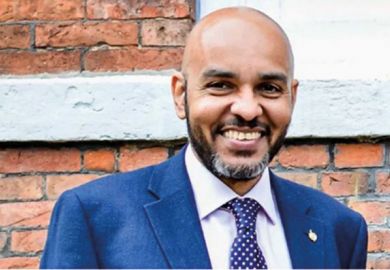Source: Alamy
It’s cold outside: those without research council backing find it hard to join in
UK universities are wrestling with a “two-tiered” approach to delivering PhDs as a result of the introduction of the research councils’ doctoral training centres, a conference has heard.
Under the model, students are funded for four years and receive structured skills training as part of a cohort, often in interdisciplinary centres that can span multiple institutions. However, international students are usually ineligible for funding from the centres.
Like UK students without research council backing or a match-funded studentship - who typically can access just three years of funding - overseas students struggle to find time to participate in extra training even where the centres offer it, said Tessa Payne, head of the Graduate School at the University of Nottingham.
“One of the things we’re wrestling with is the almost two-tier approach to the PhD,” she told the International Conference on Developments in Doctoral Education and Training, held in Edinburgh on 11 and 12 April.
At an institution where 50 per cent of PhD students are from overseas, the challenge was to ensure that the doctoral training centre PhD was not perceived as “gold standard”, at the expense of “the other one”, which most international students take, she said.
The Engineering and Physical Sciences Research Council adopted the doctoral training centre model as its primary method for PhD funding in 2009, with three other councils since following suit.
Ms Payne told the conference, organised by the UK Council for Graduate Education, that although the cross-institutional nature of the “resource- intensive” centres could result in a better experience for the student, “an awful lot of work” needed to go on behind the scenes.
Other challenges of the new model, highlighted at the event, included collaborating with universities across long distances and working with institutions with which there were few existing links.
“It’s completely unlike working in collaborative research projects, because there you choose people on the basis of expertise. In this case, you’re choosing institutions for all sorts of pragmatic reasons,” said Rosemary Deem, vice-principal for education at Royal Holloway, University of London.
Gavin Boyce, doctoral development team leader at the University of Sheffield, drew attention to the fact that the EPSRC’s mid-term review of its centres had asked whether universities had been able to make economies of scale.
“A question I’d like to ask the research councils is, if you are looking for examples of economies of scale, what might they be?” he told Times Higher Education after the event. “Because everything so far has been about extra resources and enriching the experience, and all of that comes with an overhead.”
Other issues relating to the centres included aligning collaborating institutions’ governance, regulations and marking schemes, as well as allocating funding, which generally the council gives directly to the lead institution.
David James, director of the Economic and Social Research Council Wales Doctoral Training Centre, said he felt that people in higher education had been “very good at making a virtue of a necessity”. He added: “You could argue actually that [doctoral training centres] are a result of Treasury cuts in the last Comprehensive Spending Review, and what we’ve acquired are costs that used to be borne by the research councils.”
Register to continue
Why register?
- Registration is free and only takes a moment
- Once registered, you can read 3 articles a month
- Sign up for our newsletter
Subscribe
Or subscribe for unlimited access to:
- Unlimited access to news, views, insights & reviews
- Digital editions
- Digital access to THE’s university and college rankings analysis
Already registered or a current subscriber? Login




